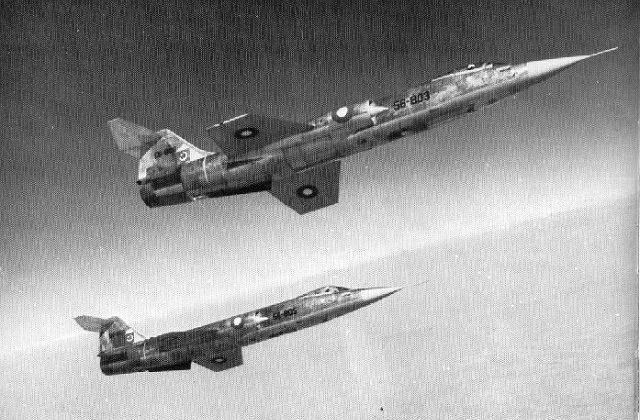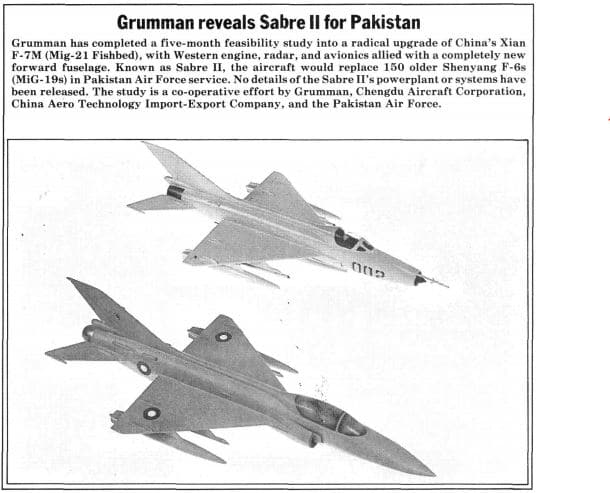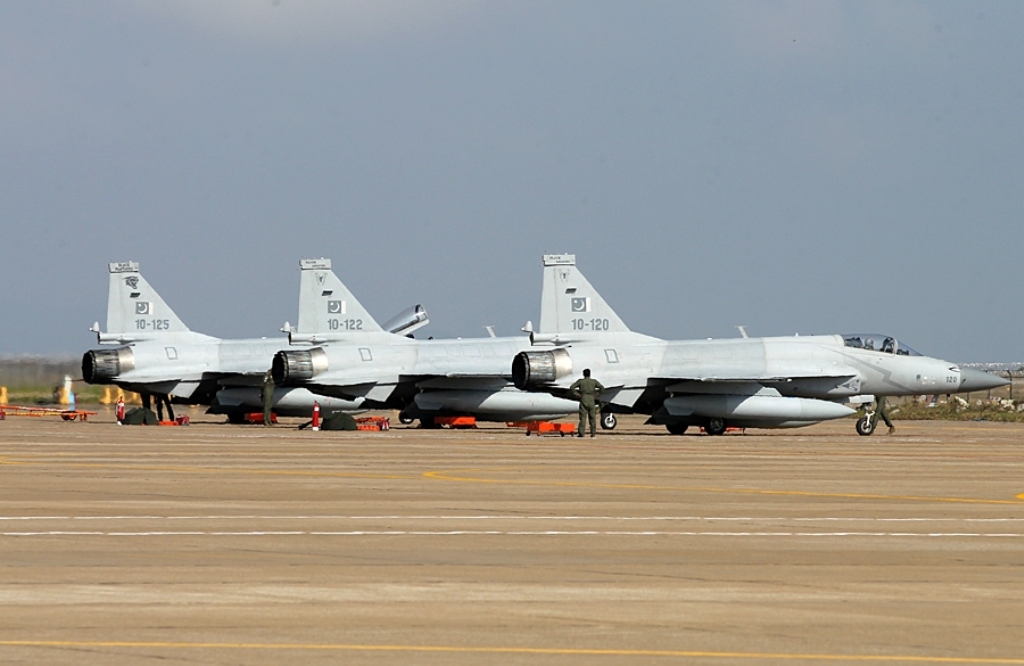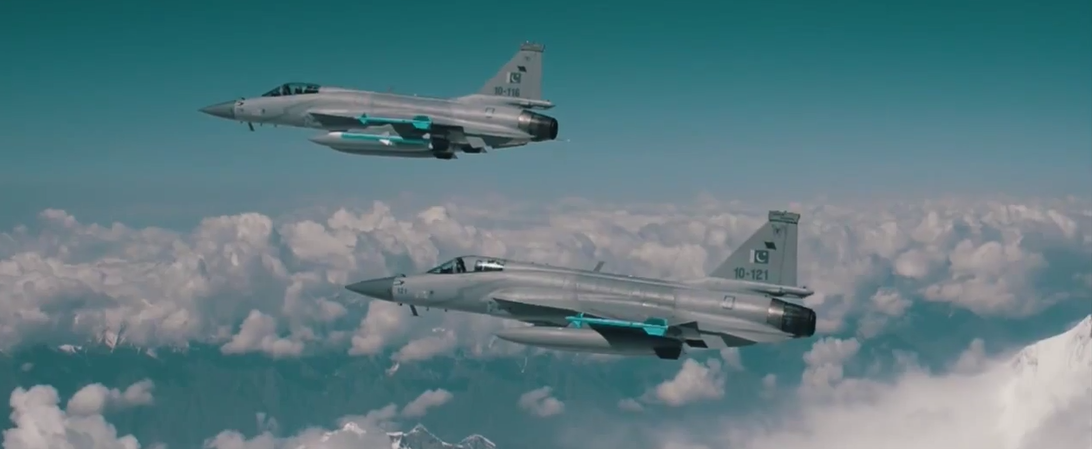3290Views 2Comments

The JF-17 (Part 1): A Wave of Change for the Pakistan Air Force
Note: This was Quwa’s very first article, published over four years ago in 2015.
Whether it be wars with its rival India or periods of not-so-great relations with the U.S, the PAF has often suffered as a result of military embargoes. Other than Pakistan’s poorly managed economic affairs, sanctions have without doubt been the biggest culprit to the qualitative and quantitative gap now exhibited between the PAF and its primary adversary, the Indian Air Force (IAF). At no point was this more apparent during the 1965 Indo-Pak War and in the 1990s.
In 1965, Pakistan’s decision to militarily engage with India over Kashmir (starting first with Operation Gibraltar – the Pakistan Army’s failed attempt to wrestle away the region via low-intensity war) was not viewed in positive light by the U.S, Pakistan’s main patron of financial and military support until that point. With its 100% American-built fighter fleet cut-off from a steady supply of spare parts and attrition replacements, the PAF’s medium to long-term capacity to fight was cut down.

In the 1990s, Pakistan was on the receiving end of the Pressler Amendment, a piece of American legislation designed to stop the Pakistani military from developing nuclear weapons. In 1988-1989 the Pakistan Air Force had hoped to build a substantial portion of its operational fleet around the F-16A/B, but Pressler made Pakistan’s abandonment of its nuclear program a prerequisite to the delivery of those aircraft. 28 of the 71 ordered F-16s were built, and until the early 2000s, they had been kept in storage in the U.S. The U.S Air Force (USAF) and U.S Navy took ownership of them, with the latter using them as aggressor aircraft for training. The 14 USAF aircraft were eventually delivered to the PAF as part of George Bush Jr’s efforts to win over the Pakistani military’s support in the War on Terror. But in the interim period the PAF had to acquire surplus Mirage III and V aircraft from Australia and France as a means to help soothe the gap left by the non-delivered F-16A/Bs. And while it did try to acquire the Mirage 2000 from France in lieu of the F-16s, public corruption and poor public finances caused those efforts to collapse.

Although the idea of manufacturing modern jet fighters in Pakistan was explored since as far back as the 1950s, the notion gained serious momentum in the late 1980s when the Sabre II program was studied.[1] At that time the PAF was looking to replace its ageing F-6s (Chinese variant of the Soviet MiG-19) with a modern low-cost multirole fighter. The idea basically revolved around taking the Chinese F-7M (a MiG-21 variant) and heavily modifying it to fit a Pratt & Whitney or General Electric turbofan engine and a powerful radar (reportedly the AN/APG-66, i.e. the radar used on the F-16 at the time).[2]

The Sabre II was envisaged as a collaboration between the PAF, Chengdu Aircraft Corporation (CAC) and Grumman Aerospace.[3] It was hoped that the U.S would supply the turbofan engine, radar and avionics suite. In the end the project was canned, primarily as a result of U.S sanctions, but also potentially the reality that the design might have been too limited for long-term use. At the end of the day the Sabre II was still based on the F-7, which in turn is a variant of the 1950s-era MiG-21. But with the Pressler-sanctions taking their toll on the PAF’s F-16 fleet and cutting the PAF from acquiring spare parts and attrition replacements for its most modern fighter, urgency for a locally-sourced fighter became critical. In 1994 the PAF accepted an offer from the China National Aero-Technology Import and Export Corporation (CATIC) to jointly-develop a new lightweight multirole fighter, then known as the Super-7.[4]
The Super-7’s design was finalized in 1999, and sometime later, it was decided by the PAF to decouple the program’s airframe development from the development of its electronics (e.g. radar). This was a significant change in that the development of avionics or radars was no longer dependent on the airframe, and vice-versa. This helped keep matters fluid in that should a new kind of system were to arise on the electronics front (where the industry moves quickly), the PAF could readily incorporate those shifts onto the platform without a major lag time. This helped ensure that the final product would be in line with the expectations of the day it rolls out, not the day when it is finalized on the drawing board.
The selected engine was the Klimov RD-93 from Russia, a variant of the RD-33 used on the MiG-29. The PAF was and still is satisfied with its choice, and it may hope that this avenue will continue by including the more powerful RD-93MA. Western turbofans were considered, but the risk of sanctions and reality of weak public finances on Pakistan’s part must have firmly excluded those routes. China is also developing its own engines for the fighter, most notably the WS-13[5] (and possibly WS-17 if is indeed a different program from the WS-13), but I doubt the PAF would select them when it can still acquire the RD-93.The first prototype rolled out and flew in 2003, and the Super-7 was given a new name – JF-17 Thunder. Since then the fighter had seen a few significant changes to its airframe. I will explore these changes in greater detail in another article, but in short, the JF-17’s airframe saw numerous aerodynamic improvements, most notably to the leading edge root extensions (LERX) and air intakes.

The final electronics suite (i.e. radar, avionics, EW/ECM, etc.) was drawn from Chinese vendors such as the Nanjing Research Institute of Electronics Technology (NRIET). I will go into the specifics of each current (and future) subsystem in a subsequent article, but needless to say, the JF-17 Block-I currently in service with the PAF is equipped with a modern radar and avionics suite. Since its induction with the No. 26 squadron in February 2010, the JF-17 has (alongside the new and upgraded F-16s) infused the PAF with greatly improved air-to-air (A2A) and air-to-surface (A2S) combat capabilities.
.jpg)


With 54 JF-17s in service across three squadrons the PAF is on-track to meeting its requirement for 150-200 aircraft. Production is shared between the Pakistan Aeronautical Complex (PAC) in Kamra and CAC in Chengdu. Under the original workshare agreement, PAC produces 58% of the airframe, with the remainder imported from China.[6] At present the PAC’s annual rollout rate is set to 16 aircraft (i.e. a squadron), but the facility reportedly has the capacity to produce 25 fighters per year.[7]
One may feel tempted to compare the JF-17 to its contemporaries, particularly the Indian Tejas and the JAS-39 Gripen. While there is definitely a place for such assessments, I am more inclined (in this piece especially) to evaluate the JF-17 on its own merits, specifically in terms of whether it substantively improves the combat capabilities of the PAF. One of the subtle notions of localization, especially in the case of a financially-strained country such as Pakistan, is that it does not translate into a genuine improvement compared to imported solutions. Some may be inclined to argue that the PAF would have ultimately been better off importing a large number of surplus F-16s, new J-10s and/or (if we really want to stretch the imagination) surplus Mirage 2000-5/-9s.
While the theory is sound, especially as we are talking about mature and trusted platforms that beat the JF-17 on range, payload and electronics (especially in terms of radar and ECM/EW suites), the idea rests on a few assumptions. The first assumption is that the PAF would always have access to spare-parts and attrition replacements, and while that may be true in times of stability, Pakistan is never too far away from a situation or controversy that can threaten its supply of arms. The JF-17 addresses this problem by ensuring that the PAF can continue inducting modern aircraft in such times of crises.
The second assumption is that the acquisition of imported platforms will enable the PAF to readily pair these platforms with the munitions of its choice. With the possible exception of the J-10B, it is highly unlikely that the PAF could readily integrate diversely-sourced stand-off air-to-surface munitions to a platform it does not own. Yes, France might be more willing to see the Ra’ad air-launched cruise missile (ALCM) on one of its current platforms, but there will always be some kind of friction, be it a technical hurdle, a commercial licensing issue, or (particularly in the case of the U.S) a supplier-side obstacle stemming from seller’s strategic needs and concerns.
With the JF-17 the PAF is not limited to acquiring munitions from a single source nor is encumbered by restrictions set by an external supplier. Through its ownership of the program, it can choose to equip the JF-17 with munition systems of its choice (based on what it can acquire and/or develop). Over the next 5-10 years (as the Block-II and Block-III JF-17s are inducted) we will see the PAF’s JF-17 fleet equipped with air-to-air and air-to-surface weapon systems from China, Brazil (Mectron MAR-1 anti-radiation missiles), the local industry (e.g. GIDS Takbir precision-guided-bomb kits), and potentially even South Africa (A-Darter high-off-bore-sight air-to-air missile) and Turkey. The advantage for the PAF is that it can readily pair the systems that are available to it commercially at-will to its backbone fighter. Not only that, but it can also build redundancy, e.g. source beyond-visual-range air-to-air missiles (BVRAAM) from multiple suppliers, as opposed to limit itself to a single vendor, as is the case with the F-16 (which exclusively uses in the AIM-120C5 in the PAF).
For my concluding point, astute readers may have picked up on something interesting within the details I discussed above. If you have not caught it, then know it is the point that the JF-17 can be equipped with many of the air-to-air and air-to-surface munitions found on more expensive fighters. Specific performance benchmarks aside, the JF-17’s various munitions can be as contemporary and forward-leaning as those found on say the JAS-39E/F Gripen. A good example of this is the A-Darter, a joint-program between South Africa’s Denel and Brazil’s Mectron to develop a high-off-bore-sight (HOBS) within-visual-range air-to-air missile (WVRAAM). The A-Darter is reportedly a frontrunner for the PAF’s requirement of a HOBS WVRAAM for use on the JF-17.[8]
The JF-17 is a modern and cost-effective platform capable of taking on a wide range of critical tasks for the PAF. In the 1990s and 2000s the vast majority of operations would be undertaken by specially-designated and equipped aircraft: F-7P for point defence, A-5 for close air support, and the Mirage III/V for strike and air-to-air engagements. Not only is the JF-17 capable of performing each of those tasks, but it is superior to each of those platforms in performance (be it range, payload, capability of radar and avionics, etc). From being able to effectively defend Pakistani airspace to being capable of inflicting damage on key targets from stand-off ranges over land and sea, the JF-17 is destined to play an indispensable role for not just the Pakistan Air Force, but the Pakistani military at large.
——————————————————————————————————————————
[1] “Grumman reveals Sabre II for Pakistan.” Flight International. 19 September 1987. Page 11: http://www.flight global.com/pdfarchive/view/1987/1987%20-%201745.html?search=grumman%20sabre%20II
[2] “West Updates China’s best.” Flight International. 26 September 1987. Page 44-45: http://www.flightglobal. com/pdfarchive/view/1987/1987%20-%201859.html
[3] Ibid.
[4] Alan Warnes. “JF-17 Thunder: Pakistan’s multi-role fighter.” Note: a special publication released by the Pakistan Air Force during the Paris Air Show of 2015.
[5] Richard D Fisher Jr. “Paris Air Show 2015: JF-17 fighter flying with indigenous Chinese turbofan.” IHS Jane’s Defence Weekly. 17 June 2015: http://www.janes.com/article/52308/paris-air-show-2015-jf-17-fighter-flying-with-indigenous-chinese-turbofan
[6] Alan Warnes. “JF-17 Thunder: Pakistan’s multi-role fighter.” Note: a special publication released by the Pakistan Air Force during the Paris Air Show of 2015.
[7] “With new JF-17, Pakistan aims for boost to defence exports.” Dawn News. 07 December 2014: http://www. dawn.com/news/1149351
[8] Alan Warnes. “JF-17 Thunder: Pakistan’s multi-role fighter.” Note: a special publication released by the Pakistan Air Force during the Paris Air Show of 2015.



2 Comments
by Haad Bodla
Love your articles, keep it up
by saqrkh
Thanks! Means a lot 🙂